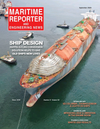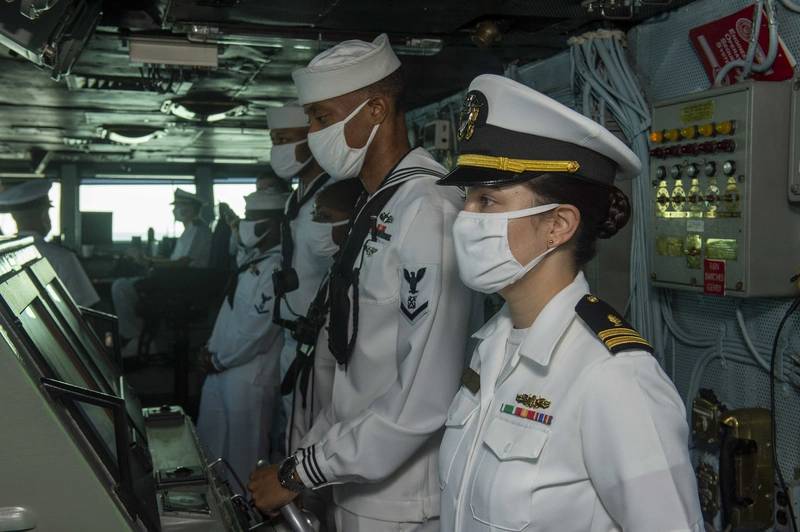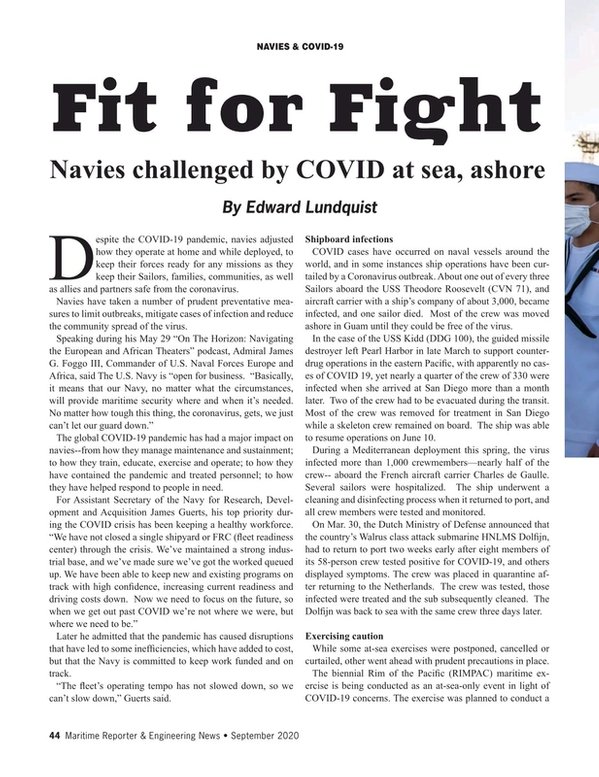
Fit for Fight: Navies challenged by COVID at sea, ashore
Despite the COVID-19 pandemic, navies adjusted how they operate at home and while deployed, to keep their forces ready for any missions as they keep their Sailors, families, communities, as well as allies and partners safe from the coronavirus.
Navies have taken a number of prudent preventative measures to limit outbreaks, mitigate cases of infection and reduce the community spread of the virus.
Speaking during his May 29 “On The Horizon: Navigating the European and African Theaters” podcast, Admiral James G. Foggo III, Commander of U.S. Naval Forces Europe and Africa, said The U.S. Navy is “open for business. “Basically, it means that our Navy, no matter what the circumstances, will provide maritime security where and when it’s needed. No matter how tough this thing, the coronavirus, gets, we just can’t let our guard down.”
The global COVID-19 pandemic has had a major impact on navies--from how they manage maintenance and sustainment; to how they train, educate, exercise and operate; to how they have contained the pandemic and treated personnel; to how they have helped respond to people in need.
For Assistant Secretary of the Navy for Research, Development and Acquisition James Guerts, his top priority during the COVID crisis has been keeping a healthy workforce. “We have not closed a single shipyard or FRC (fleet readiness center) through the crisis. We’ve maintained a strong industrial base, and we’ve made sure we’ve got the worked queued up. We have been able to keep new and existing programs on track with high confidence, increasing current readiness and driving costs down. Now we need to focus on the future, so when we get out past COVID we’re not where we were, but where we need to be.”
Later he admitted that the pandemic has caused disruptions that have led to some inefficiencies, which have added to cost, but that the Navy is committed to keep work funded and on track.
“The fleet’s operating tempo has not slowed down, so we can’t slow down,” Guerts said.
Shipboard infections
COVID cases have occurred on naval vessels around the world, and in some instances ship operations have been curtailed by a Coronavirus outbreak. About one out of every three Sailors aboard the USS Theodore Roosevelt (CVN 71), and aircraft carrier with a ship’s company of about 3,000, became infected, and one sailor died. Most of the crew was moved ashore in Guam until they could be free of the virus.
In the case of the USS Kidd (DDG 100), the guided missile destroyer left Pearl Harbor in late March to support counter-drug operations in the eastern Pacific, with apparently no cases of COVID 19, yet nearly a quarter of the crew of 330 were infected when she arrived at San Diego more than a month later. Two of the crew had to be evacuated during the transit. Most of the crew was removed for treatment in San Diego while a skeleton crew remained on board. The ship was able to resume operations on June 10.
During a Mediterranean deployment this spring, the virus infected more than 1,000 crew members—nearly half of the crew-- aboard the French aircraft carrier Charles de Gaulle. Several sailors were hospitalized. The ship underwent a cleaning and disinfecting process when it returned to port, and all crew members were tested and monitored.
On Mar. 30, the Dutch Ministry of Defense announced that the country’s Walrus class attack submarine HNLMS Dolfijn, had to return to port two weeks early after eight members of its 58-person crew tested positive for COVID-19, and others displayed symptoms. The crew was placed in quarantine after returning to the Netherlands. The crew was tested, those infected were treated and the sub subsequently cleaned. The Dolfijn was back to sea with the same crew three days later.
 Safe Navigation: Sailors navigate the ship in the bridge of the Nimitz-class aircraft carrier USS Dwight D. Eisenhower (CVN 69). Dwight D. Eisenhower Carrier Strike Group has remained underway as a ready strike group during the COVID-19 global pandemic. U.S. Navy Photo by Mass Comms Specialist 3rd Class Sawyer Haskins
Safe Navigation: Sailors navigate the ship in the bridge of the Nimitz-class aircraft carrier USS Dwight D. Eisenhower (CVN 69). Dwight D. Eisenhower Carrier Strike Group has remained underway as a ready strike group during the COVID-19 global pandemic. U.S. Navy Photo by Mass Comms Specialist 3rd Class Sawyer Haskins
Exercising caution
While some at-sea exercises were postponed, cancelled or curtailed, other went ahead with prudent precautions in place.
The biennial Rim of the Pacific (RIMPAC) maritime exercise is being conducted as an at-sea-only event in light of COVID-19 concerns. The exercise was planned to conduct a meaningful exercise with maximum training value but minimum risk to the force, allies and partners, and the people of Hawaii. “In these challenging times, it is more important than ever that our maritime forces work together to protect vital shipping lanes and ensure freedom of navigation through international waters,” said Commander, U.S. Pacific Fleet Adm. John Aquilino. “And we will operate safely, using prudent mitigation measures.”
As the U.S. Navy continues to limit the spread of COVID-19, RIMPAC 2020 is not scheduled to include social events ashore. Joint Base Pearl Harbor-Hickam will be accessible for logistics support, with a minimal footprint of staff ashore for command and control, logistics, and other support functions.
According to a NATO statement from Allied Maritime Command regarding the recent Dynamic Mongoose multi-national ASW exercise, just one sailor with COVID-19 could mean the entire ship becomes infected. “All our missions have robust procedures in place to protect our people and prevent the spread of the virus. The particular action of each ship is dictated by the ship’s national policies. In general, it’s limiting contact between ships, hand washing, disinfecting of supplies transferred, routine ship dis-infecting and, when in port for resupply, crews are not allowed to leave their ships. Our ships are essentially self-quarantined in place as units,” the statement read.
“It is vital that we are able to conduct our operations and tasks regardless of the threat from COVID-19. Reducing the risk of getting the virus on board our ships in the task group is therefore one of my top priorities”, said Commodore Yngve Skoglund of the Royal Norwegian Navy, Commander of Standing NATO Maritime Group One (SNMG1), and who led the ships participating in the Dynamic Mongoose exercise.
Ships from Standing NATO Mine Countermeasures Group Two (SNMCMG2) that were participating in the Dynamic Manta ASW exercise in the Mediterranean started implementing protective measures starting as early as Feb 27, including a wet chloramine carpet at the flagship entrance, antibacterial gel cans, masks and gloves.
Around 30 ships from 19 NATO Allied and partner nations participated in the annual BALTOPS maritime exercise in the Baltic in June, although the amphibious component of the exercise was cancelled along with ships visits and personnel exchanges because of COVID concerns.
Royal Danish Navy Commander s.g. Henning Knudsen-Hauge, Commander of Standing NATO Mine Countermeasures Group One, said his ships disinfected provisions and spare parts taken on board, and eliminated physical contact with personnel outside the group. Port visits were replaced by short logistical stops without shore leave, and all official calls were either cancelled or digitalized.
People, training and education
Tens of thousands of Sailors as well as family members, who were scheduled to move to a new duty station were affected by a “stop movement order” in mid-march that lasted about five months and temporarily halted all travel. This took place right in the middle of the busy summer months when families typically execute permanent change of station moves between school years. Many Sailors couldn’t depart for their next assignment until their relief had reported aboard.
Training and education have been affected by the pandemic. In the U.K., Cadets from Royal Navy university units are volunteering to drive ambulances, treat coronavirus patients, look after the vulnerable in lockdown and even advise political leaders – at the same time as they continue their studies.
As the pandemic spread, service academy students were sent home and completed their coursework online. The U.S. service academies created online workouts and exercise sessions for students to keep up their physical training.
The U.S. Naval Academy and Coast Guard Academies held virtual graduation and commissioning ceremonies. The usual commissioning ceremonies for the Naval Reserve Officers Training Corps and universities around the country were cancelled and replaced with virtual events.
The Marquette University NROTC unit commissioned its midshipmen as ensigns and second lieutenants administering the oath of office during in a ceremony carried on YouTube. The new officers were in uniform at their homes, and had their families and friends put on their new insignia as officers.
New recruits attending the Navy’s enlisted boot camp at Recruit Training Command in Great Lakes in Illinois, are sequestered for a 14-day ROM as a COVID mitigation measures. Incoming freshmen at the U.S. Naval Academy in Annapolis, Md., underwent a 14-day ROM in Bancroft Hall, the academy’s huge dormitory.
The Naval War College in Newport R.I., is using tools like Zoom, Blackboard and Microsoft Teams for orientation and instruction. The summer quarter education at Naval Postgraduate School in Monterey, Calif, will be delivered via distance learning, although a small number of students will be allowed to perform lab work and research and take part in classified classes. For ships at sea, the number of safe ports to visit has been dramatically reduced. Guam in the Pacific and Rota, Spain in the Mediterranean are two examples of ports where the Navy already has a presence and can ensure compliance with COVID protocols.
The crew of USS Nimitz (CVN-68) was sequestered inside the skin of the carrier for nine days of a 14-day ROM period before heading to sea for pre-deployment training.
The USS Dwight D. Eisenhower (CVN 69) and USS San Jacinto (CG 56) returned to their homeport of Norfolk, Virginia, on Aug 9th. Due to the COVID 19 pandemic, the ships remained continuously at sea for 200 days. with no port visits.
Caribbean Cooperation
France, the Netherlands and the United Kingdom are working together to provide a coordinated humanitarian response in the Caribbean, where all three nations have a presence. The French amphibious assault ship Dixmude, British primary casualty receiving ship RFA Argus and Dutch multi-function support ship for amphibious operations HNLMS Karel Doorman are now in the region to help with the COVID-19 crisis currently affecting their overseas territories.
RFA Argus and her 100-bed medical facility, was already scheduled to sail for the Caribbean, a region that contends with severe hurricanes and tropical storms each year, and Argus is prepared to respond if needed, but she is well equipped to assist British Overseas Territories dealing with the COVID-19 outbreak. In addition to Dixmude, the French navy mobilized its other two its Mistral-class amphibious assault ships in response to the coronavirus pandemic. Mistral was dispatched to support the French territory of Reunion in the Indian Ocean, and Tonnerre was sent to Corsica. The Karel Doorman carries a medical support unit and can also supply the other with fuel. A coordination cell has been set up on the French island of Martinique to manage cooperative efforts when necessary. Looking to the not-too-distant future, normality won’t return until the virus can be prevented. Russia already claims to have a vaccine. A number of promising multi-national efforts are underway. The U.S. Department of Defense claims that the public-private partnership “Operation Warp Speed,” is on track to meet its goal of delivering 300 hundred million doses of safe and effective COVID-19 vaccines by the end of the year. In any event, navies will likely play a role in testing and administration of new vaccines to combat COVID 19.
Global impact
Even in February navies were becoming aware of the virus. When the Royal Malaysian Navy (RMN) ship KD Lekiu was assigned to escort a floating superstructure owned by Malaysian oil company Petronas from South Korea to Malaysia, everyone on board was given a clean bill of health prior to leaving home port, and again when they arrived at Geoje-do, an island off the port city of Busan.
According to RMN Lt. Norzuhaira Ruhanie, a new normal started to creep into the ship’s operation and routine when the global pandemic was declared, including a greater focus on good hygiene.
“In port, masks were procured for the crew and hand sanitisers in the sick bay were put to good use,” Ruhanie said. “Social distancing was practices as much possible. The medical officer on board, Lt (Dr) Amirul Arzahar, was kept busy with regular screening of the crew throughout the return journey. The commanding officer, Captain Shaiful Nizam, realised the journey home was a form of self-quarantine for him and the crew. No crew members became infected during the mission.”
The RMN is working closely with the Malaysian Armed Forces’ Health Service Division and the Army’s Royal Medical and Dental Corps, in preparing a standard operating procedure,” she said. “Regular screening and health checks are now required of all navy personnel involved in routine operations.”
In Thailand, the Navy and other services had to cut their budgets by a third to enable the government to fight the pandemic. Among the cost-cutting measures being implemented, the Navy is postponing procurement of its second and third submarines as a result.
The Bangladesh Navy assisted the civil administration in implementing the government’s directives to fight coronavirus. Navy personnel distributed food, water, masks and disinfectant soap to local communities, and conducted an awareness campaign about social distancing and sanitation to prevent the virus transmission. The Navy had ships visiting ports and fishing villages to raise awareness among local communities about the coronavirus outbreak.
Read Fit for Fight: Navies challenged by COVID at sea, ashore in Pdf, Flash or Html5 edition of September 2020 Maritime Reporter
Other stories from September 2020 issue
Content
- Training Tips for Ships #16: Using Student Exam Results to Measure OUR Performance: Part 2 page: 12
- History and Overview of U.S. Cabotage Laws page: 14
- “It’s my dream job”: One-on-one with Søren Andersen, CEO, StormGeo page: 18
- Maritime History: Columbia Lighting the World; How Classification Can Make a Difference page: 22
- Will Customers Redefine Design and the Science of Marine Propulsion? page: 26
- New Lives for Old Ships: Inside Keppel O&M’s FLNG Conversion Solution page: 34
- Mitigating Underwater Noise page: 42
- Fit for Fight: Navies challenged by COVID at sea, ashore page: 44


